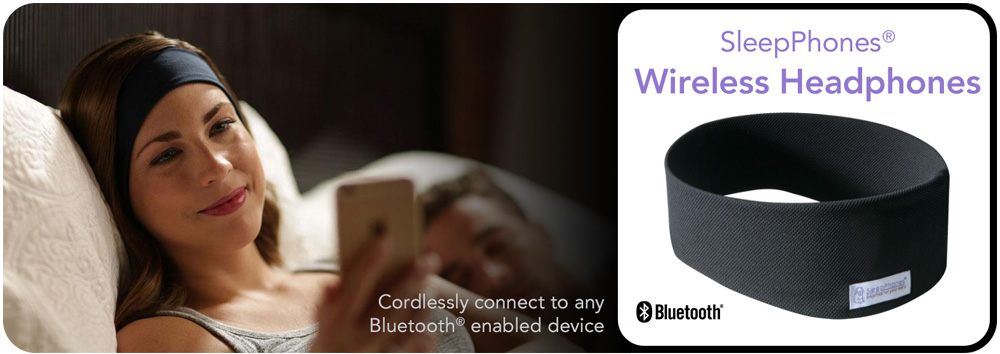The Most Comfortable Coronavirus Mask Design By A Doctor (Plus a Solution for Glasses Fogging up or Wearing With a Beard)
Step-By-Step Directions on How to Make Your Own Mask Using Household Items
Click for PDF with step-by-step directions.
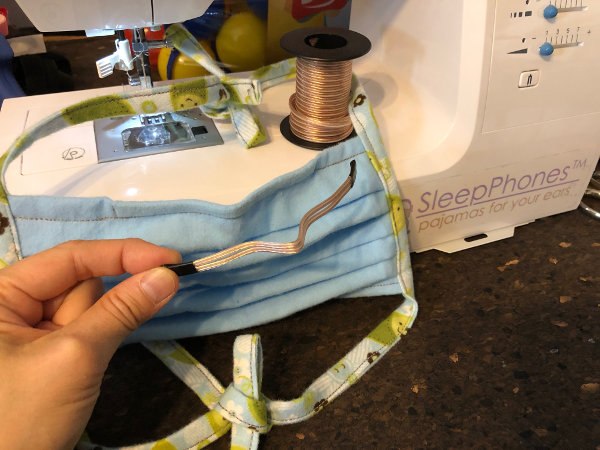
There is a June 8 update at the end of the article.
April 8, 2020
Wei-Shin Lai, M.D.
The CDC started recommending face masks a few days ago. Since we don't have many as a country, we are saving the disposable ones for our healthcare workers. Meanwhile, the rest of us get to wear homemade masks! Trust me, it can actually be more comfortable. At the grocery store, I saw a huge variety of homemade masks, some too small, some looked uncomfortable, many worn poorly, a few hanging around the neck. The best mask is one that you will actually wear. To that end, comfort is key. As a doctor, I have been scrubbed in for many surgeries during my training. I know how to wear masks.
A Mask Design for Various Sizes and Requirements
My husband has a long beard. We both wear glasses. We have a school-aged child who should probably wear a mask if he goes out too, though he has not for nearly a month now. Everyone's got a special circumstance for needing adjustments to their mask. The standard ear loop mask for a medium-sized adult fits too few people, but that's what all of the patterns out there show. This is a design that can easily vary for any special requirements.
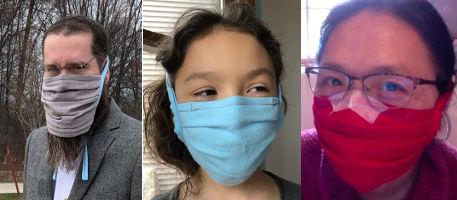
How Do I Make My Own Mask and How Long Does It Take?
Just like how my husband and I invented SleepPhones® headphones 13 years ago, we came up with our own design that works for us. I've detailed it in this PDF. It has tons of pictures and animated GIFs. Please download, scroll through, and embark on your mask making! It took me about an hour per mask by the time I got to the last mask. Everyone in the family has a mask now, including our baby who would rather chew on it.
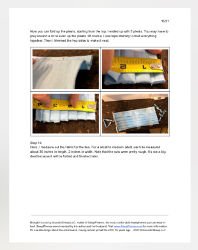
How Updates on the Virus Have Determined Who Should Wear a Mask
At the beginning of the coronavirus outbreak, I and many others felt that masks were not helpful and should be reserved for healthcare workers. The situation has changed. We have many more sick people walking around than before. We always knew that people were contagious before exhibiting symptoms, and that’s now been narrowed down to about the two days prior to feeling ill. We knew before that the virus spread via droplets (which land on surfaces and transmit via a contaminated hand touching the eyes, nose, or mouth). What we didn’t know early on was that the virus was airborne, especially when 45 people caught it from singing. It’s now been shown to linger in the air for at least three hours.
What Does Airborne Transmission Mean?
Airborne transmission means that someone who laughed in a space could have ejected miniscule particles of viruses into the air which linger for hours, light enough to float around for a long time. Then you enter that same space, say next to the bananas at the grocery store, 10 seconds later. You could breath in the virus particles and come down with COVID-19. This is an extreme example, but it’s not outside the realm of possibility. Coughing and sneezing eject more particles, but everyone knows someone who talks with saliva flying out of their mouth. (Did you hear about the Canadian Prime Minister saying “moistly” on air?)
So obviously, masks! But not so fast. Homemade and surgical masks don’t help much with airborne particles. When you breathe in, some air comes in from the sides of the mask. So the miniscule particles holding viruses could still be sucked in from any gaps in the mask. If the weave on the fabric is not tight enough, viruses can even come in from the tiny holes in the fabric itself.
N95 respirators will filter out viruses, but no one should be wearing those except healthcare workers. Plus, as I’ve discussed before, unless you have been fit tested with a specific mask, the random mask you have probably doesn’t fit well enough to prevent virus-containing air leaking in from the side. They are very uncomfortable to wear for long periods. It’s difficult to talk or have any exertion while wearing an N95.
Why Do We Have to Wear Masks?
So… no masks? Not so fast. The thing that homemade and surgical masks do best is prevent a sick person from spreading their illness. If a sick person is wearing a mask, they are far less likely to cough, sneeze, laugh, sing, or talk with spittle ejected far and wide. Since you are contagious before you feel sick, you should wear a mask before you are sick. How could you possibly know if you will be sick in the future? You can’t know. This is why everyone should wear masks.
Why Are We Really Wearing Masks...
The mask recommendation is not meant to protect the person wearing it from getting sick. The mask recommendation is to prevent anyone who has an illness from spreading it. So if you wear a mask, you are doing more to protect your neighbors than yourself. But if everyone wears a mask, then everyone is protecting everyone else. That’s the dirty little secret.
How do we convince everyone to wear a mask to protect everyone but themselves? We lie. We pretend that the masks really help the person wearing it. That way, even the selfish people out there will wear a mask, thinking that it will help themselves. Not everyone feels like they have a civic responsibility to protect other people. So if the public policy is for everyone to wear a face mask, then far fewer pre-symptomatic people will transmit the virus. That’s the real reason face masks are now recommended.
Keep wearing your mask so other people feel comfortable wearing one too. Style it up! Make it a statement. If you help set a new norm that masks are cool, then other people will feel better about wearing masks. If people around you are wearing masks, then you are protected from them! But let’s just keep this line of reasoning a secret because we really just want other people to wear their masks.
The Mask I Recommend Based on Years of Experience
Okay. Now you understand that wearing a mask is pretty much just to prevent you (and the people around you) from unintentionally ejecting spit laden with viruses. So pretty much any old mouth and nose covering will work. That’s why the CDC is recommending something as simple as a bandana or scarf. Still, is there a mask that I would recommend?
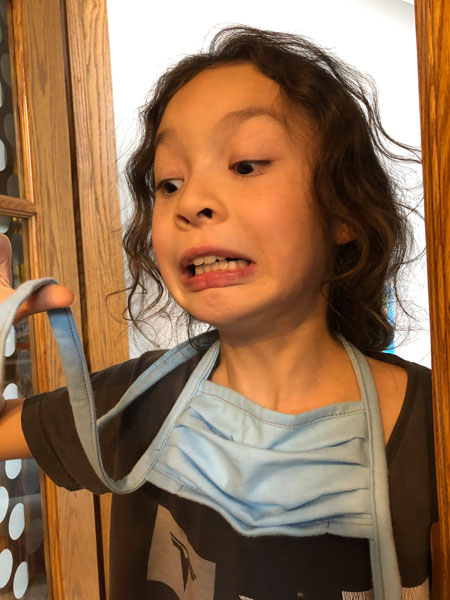
Yes. The best face mask is the face mask that you actually wear. If it’s too stuffy, you can’t make it through a grocery store run. I was happy to see many people wearing their homemade masks the other day, but I noticed that some of the people I went in with ended up with it around their neck. If it’s ill-fitting, you’ll be touching it all of the time to adjust it. If it’s uncomfortable in any way, you just might not wear it.
During medical school and through residency training, I often had to wear masks. When we held a retractor for hours while watching a surgeon perform a surgery, we had to scrub up, learn sterile techniques, and withstand hours of discomfort wearing a mask, unable to itch anything.
Doctors have gone through the gauntlet of sterile techniques. When your gloved hands have been inside a bloody abdominal cavity during surgery, you learn to not touch your face. For masks, any adjustments have to be made by an OR tech or a nurse who is not scrubbed in. So then you’re like, “up a little on the left, no - my left, pitching my eye, the tie is loose…” The last thing you want to do is to wear an ill-fitting mask that doesn’t stay on well. What I learn about masks informs my mask recommendations to you.
Things to consider for making your own mask:
- The most comfortable masks don’t have ear loops. Eventually your ears will get chaffed.
- The best ones use ties.
- The nose area must ride on the bony part of your nose, not on the soft part. It’s very uncomfortable to squash your nasal passages.
- The nose area requires a bendable metal brace. Without it, there would be too much air leakage coming in from the gap between the nasal bone and the cheeks.
- If you wear glasses, the moist air that you breathe out will fog up your glasses. You have to make a seal around the nose with tape (preferably the medical paper tape) so exhaled air has to travel elsewhere.
- If you have a beard, the mask length may need to be extended, since the bottom would not be sealed.
- The fabric should be a woven fabric, not a knitted fabric. What’s the difference? Woven fabrics don’t stretch much, so when you tie it around your face, the tiny holes between the threads don’t get bigger and let in more viruses.
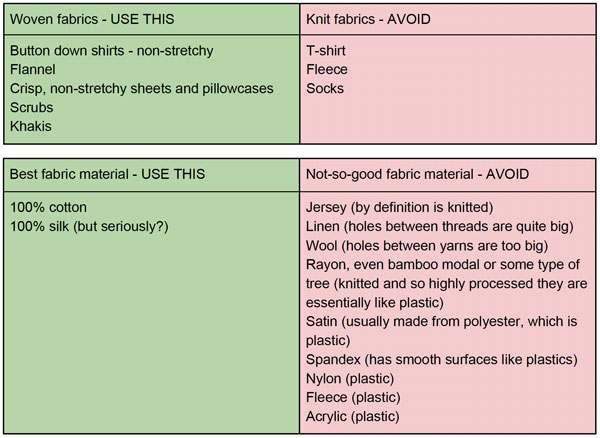
I'm listing stuff you might already have around the house so you don’t need to go out to buy any fabric. I was able to dig out an old button down shirt to repurpose, and I already had some flannel left over from a baby project. Plastic-type fabrics are not recommended because the virus survives for 3 days on plastic and metal surfaces. On wood, cardboard, and more natural materials (like cotton) with more surface area, the virus can only survive for 1 day.
There are plenty of videos and plans for making masks out there, including some very reputable places like Kaiser or JoAnn Fabrics. Some of those did not have the nose bridge wire option.
Some designs are 2-ply, with multiple layers of fabric and insertable filters, which can make breathing harder. It potentially directs airflow to come in from the sides rather than through the layer of fabric itself. Some designs don’t take into account beards, glasses, and other facial features. So I just made my own. Here’s how I made masks for everyone in my family.
Unable to sew or just want something now? We made some waterproof face mask because we had the fabric. Perfect for outdoor work, rainy areas, or extra protection for your N95 mask.
Step-by-step instructions for making your own comfortable face mask
This design features nose wire, ties, pleats, flexible design, multiple sizes, and 1-ply, flannel.
(Click for PDF with step-by-step directions)
Step 1
I found some speaker wire. Speaker wire is firm enough to shape, but not too hard. Plus, it comes with 2 wires already attached side by side so it lays flatter.
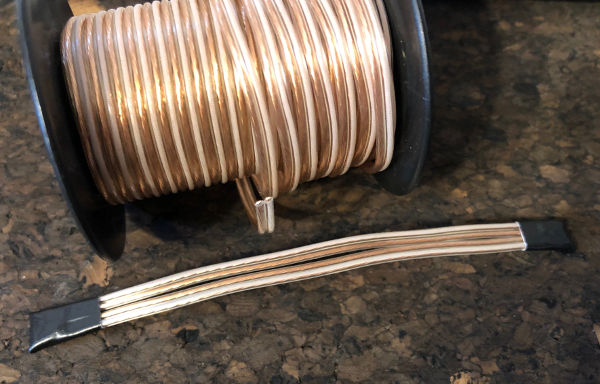
Step 2
Measure out two lengths of speaker wire. I’m doubling it up for a better hold.

Step 3
To prevent the ends from rusting when washed, I'm putting duct tape on the ends. This also pads the ends so the metal doesn't poke through the fabric. This should be an animated GIF. Hopefully you can see all of the frames.
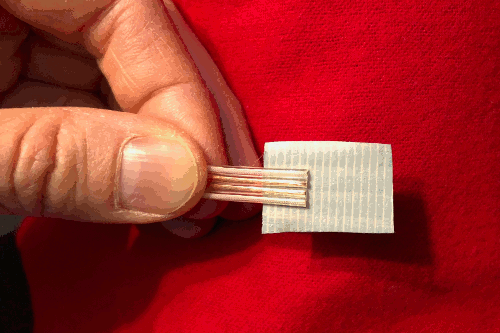
Step 4
Both sides are Duck/duct taped.
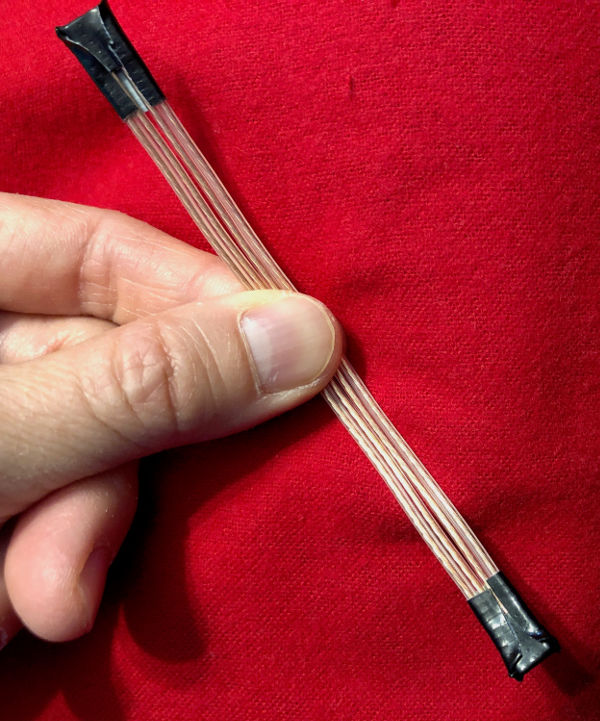
Step 5
Measure and cut out the flannel mask piece. I left a bit extra for the left and right edges so I could trim them. Here are some approximate sizes I used.

In these instructions, I am making one for a small adult with a final measurement of 9 inches wide, 4 inches high for the part covering the nose and mouth.
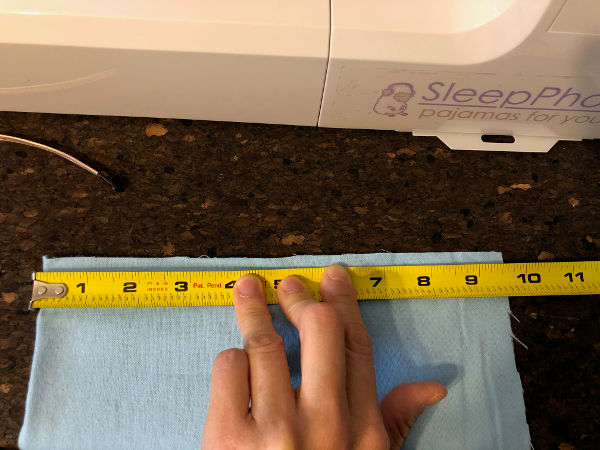
Step 6
We want to make a nice seam at the top while sealing in the metal wires. I fold down the top with the anticipation of folding that over again, while having enough fabric to sew it down. The measurements don’t have to be precise. See pictures.
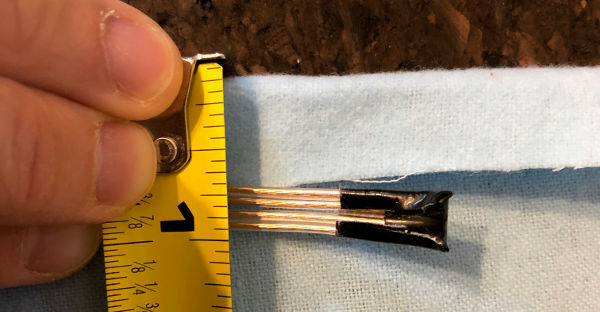
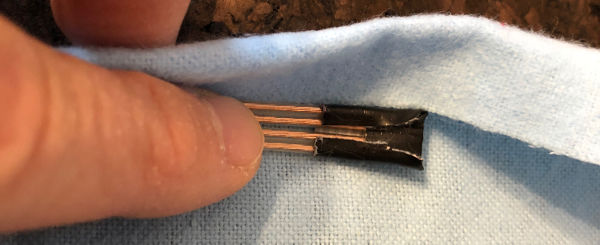
Step 7
Since I have a baby and because I generally hate sharp things, I avoid them at all costs. Feel free to use pins. I use tape to secure a fold. Plain old scotch tape. Crazy I know.
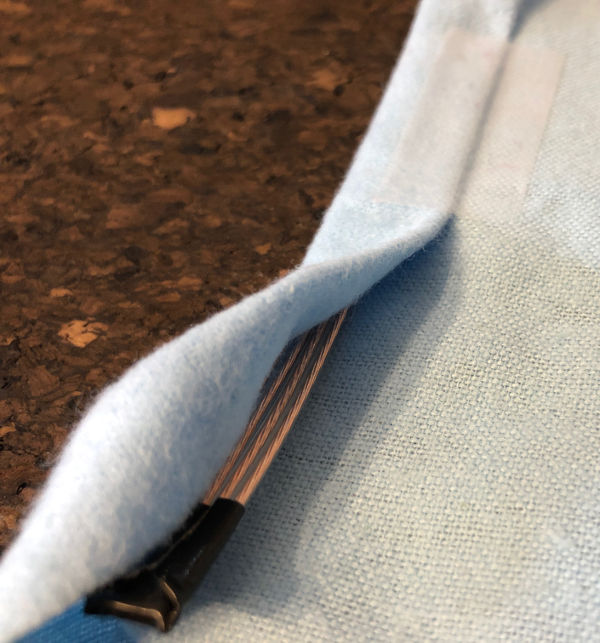
Step 8
My fingers show the edges of the metal nose piece that is now folded under.
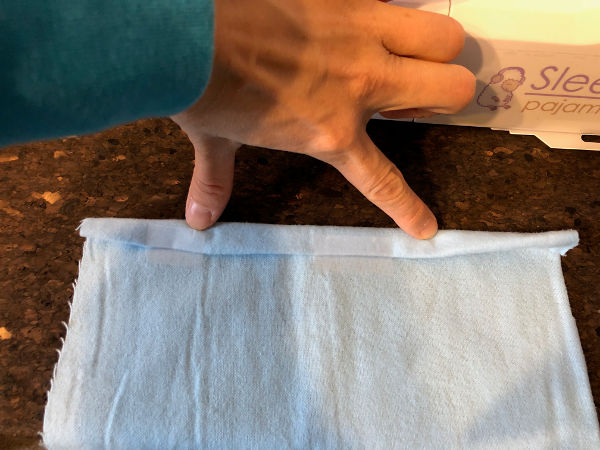
Step 9
I love the straight stretch stitch. It holds up well with washing. I’m a rank amateur with sewing, so feel free to use a different stitch if you prefer.
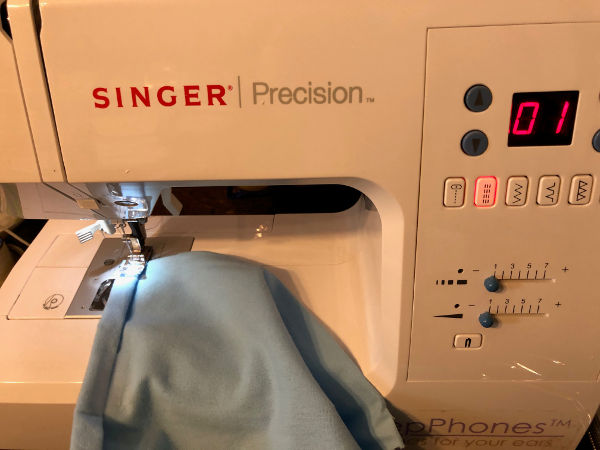
Step 10
I make sure to turn and stitch in the metal nose piece on both ends so it doesn’t slide around.
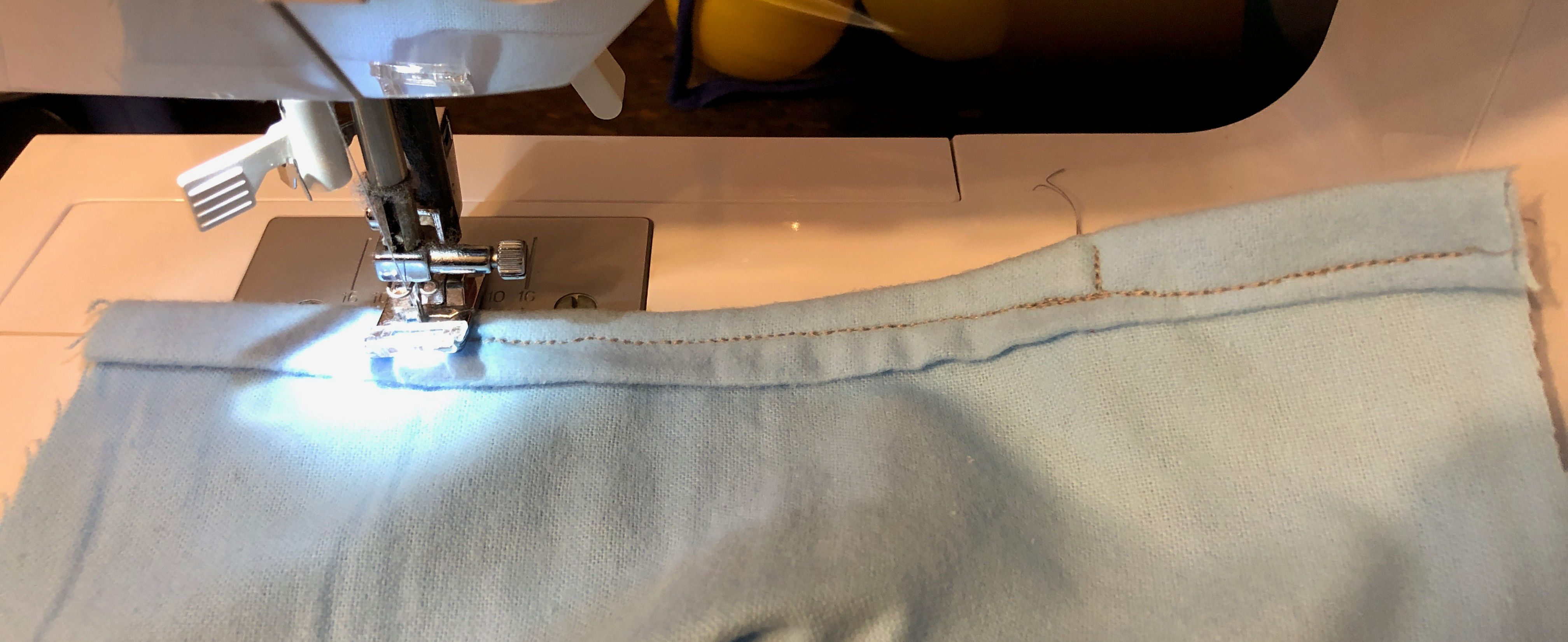
Step 11
Now the top is all done! Try out the nose area. It should work well to fold down over your nose and maintain its shape. Flatten it out before you do any more sewing.
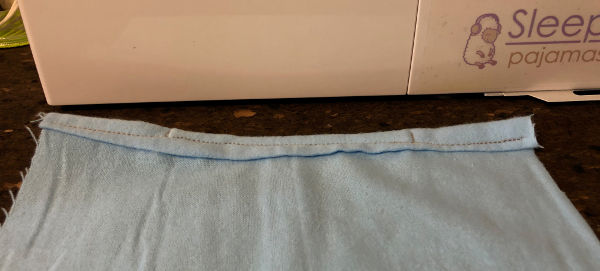
Step 12
Now we can just seam up the bottom nicely too.
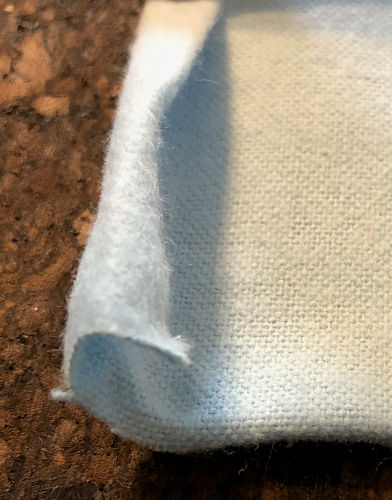
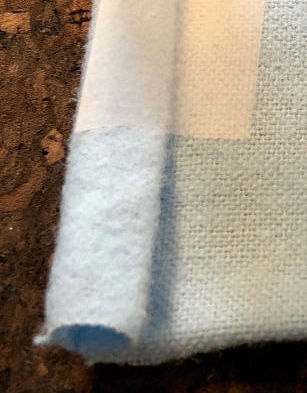
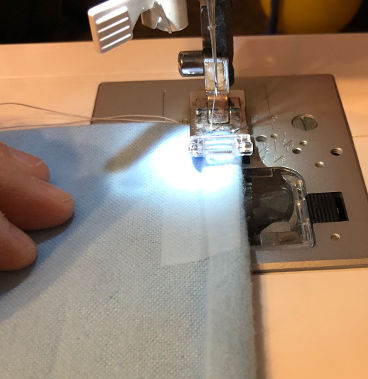
Step 13
Now you can fold up the pleats, starting from the top. I ended up with 5 pleats. You may have to play around a bit to even up the pleats. Of course, I use tape liberally to hold everything together.
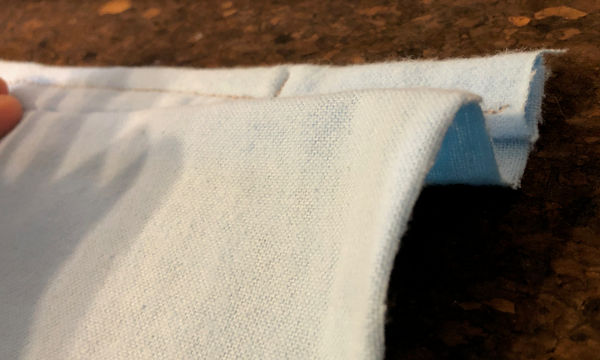
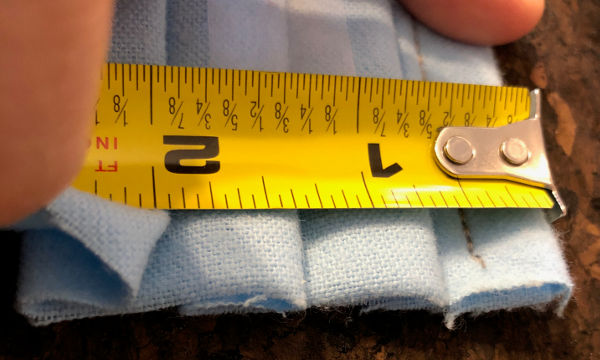
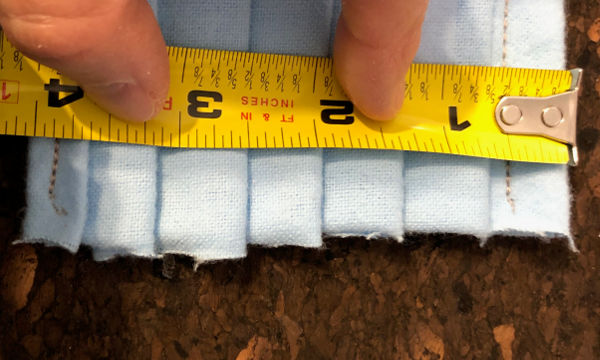
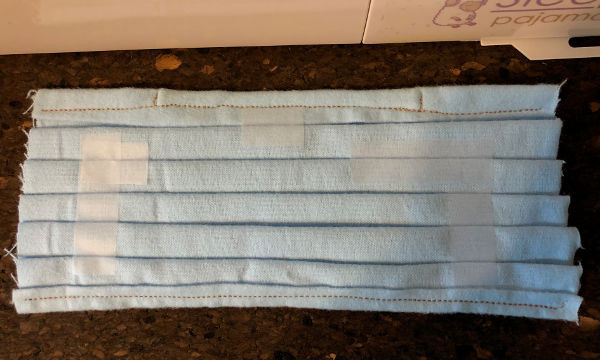
Step 14
I trimmed the two sides to make it neat.
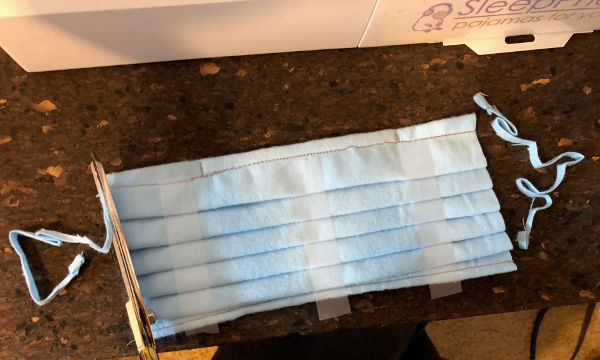
Step 15
Here, I measure out the fabric for the ties. If you have bias tape, feel free to use that. I don’t have any, so I’m just winging it. For a small to medium adult, each tie measured about 30 inches in length, 2 inches in width. Note that the cuts were pretty rough. It’s not a big deal because it will be folded and finished later.
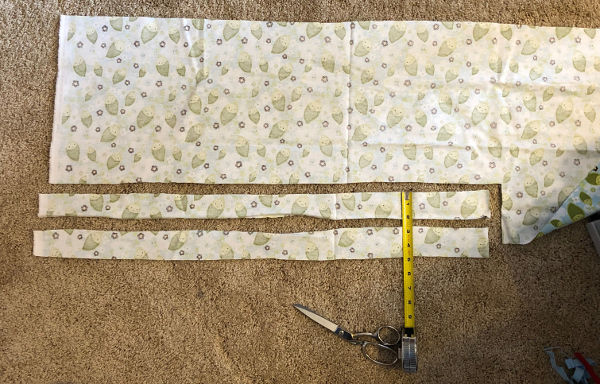
Step 16
Much like sharp pins, I don’t link super hot irons. Scotch tape is my friend. I fold in the end, fold in both sides, fold that in half, and then start taping it all down. See the animated GIF.
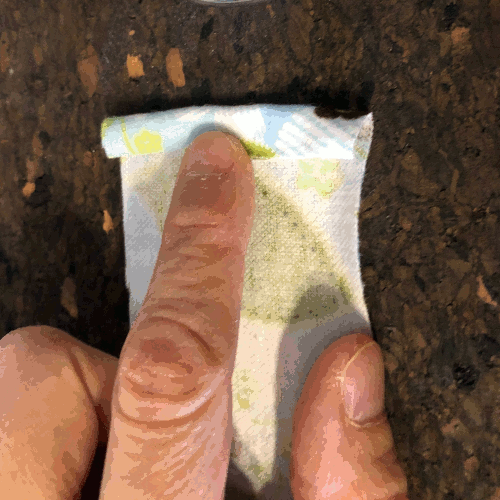
Step 17
I leave about 6 inches of gap for the mask itself. The gap is off-center because the top part of the mask needs to have the longer strap.
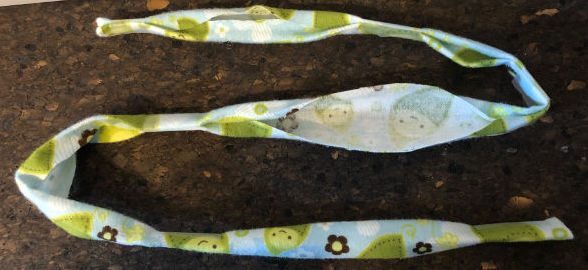
Step 18
If you want to be precise, here are the 30 inches of the strap. 15 inches are for the Top (T) strap. The Mask (M) takes about 4 inches. The Bottom (B) is about 10 inches. The longer the better for easier tying.

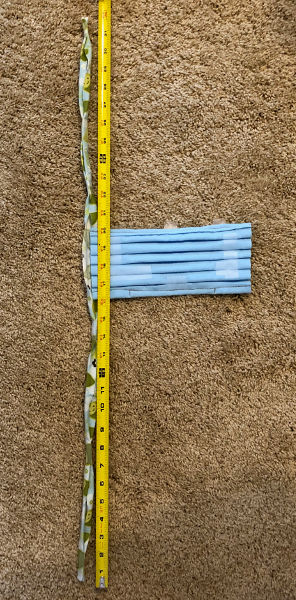
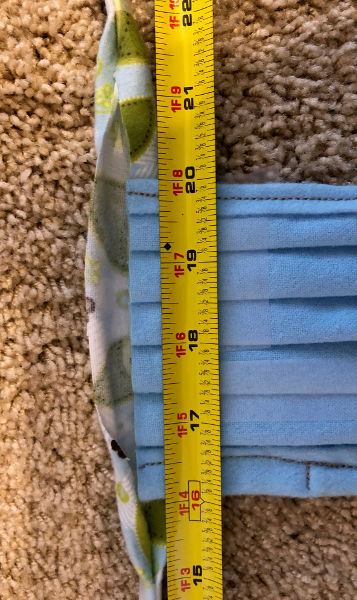
Step 19
Now, I slide in the mask part and start taping.
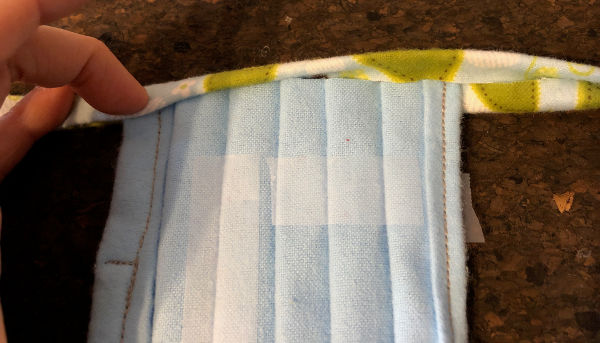
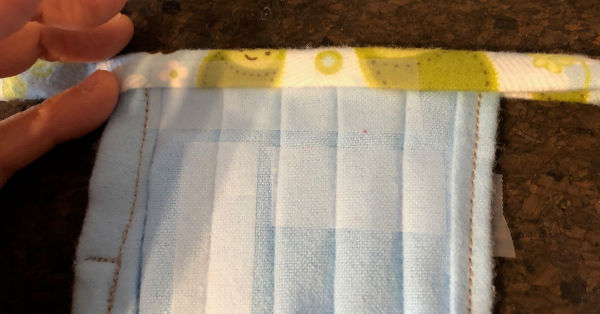
Step 20
Don't sew over the tape. It's really hard to remove afterwards. Just peel it off when you get to it.
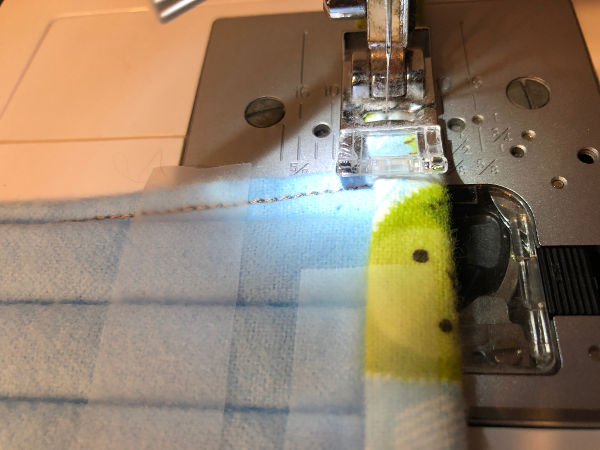
Step 21
Nice seam holding it all in!
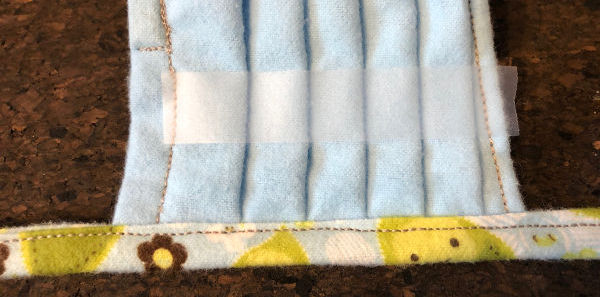
Step 22
Do the other strap.
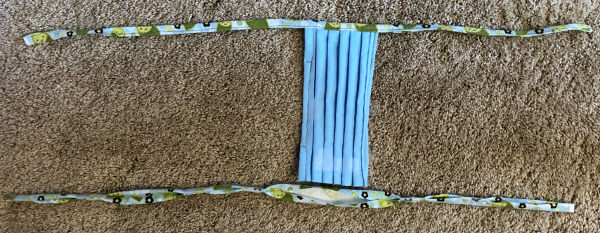
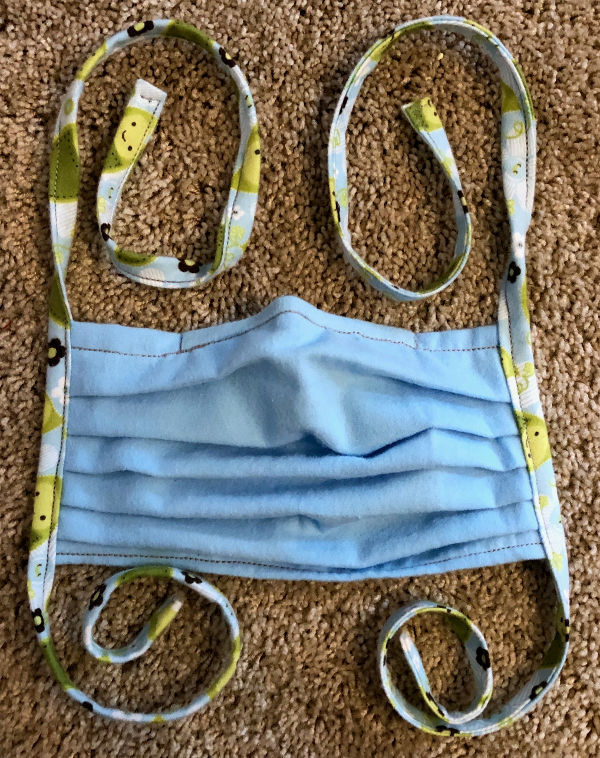
Done!
Here are some varying sizes. 6 year old, 1 year old, and me!
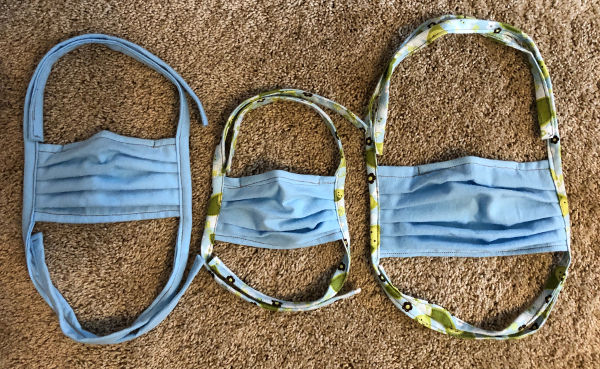
This original mask pattern is brought to you by Dr. Wei-Shin Lai, CEO of AcousticSheep LLC, inventor and
manufacturer of SleepPhones®, the most comfortable headphones you can wear in bed.


Additional photos of how Dr. Lai’s DIY masks turned out
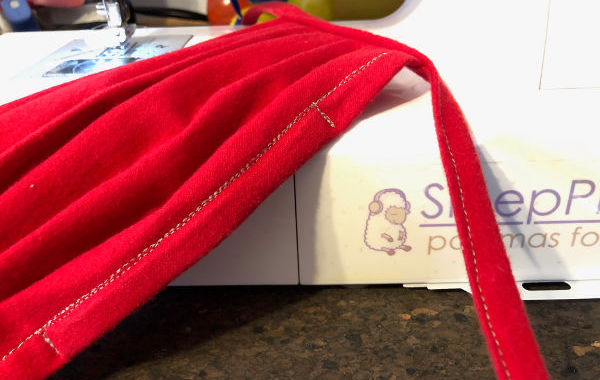
Here's my dapper husband going to the grocery store. Note how he tied his around his beard. With head movements, this might be the way to go for people with beards.
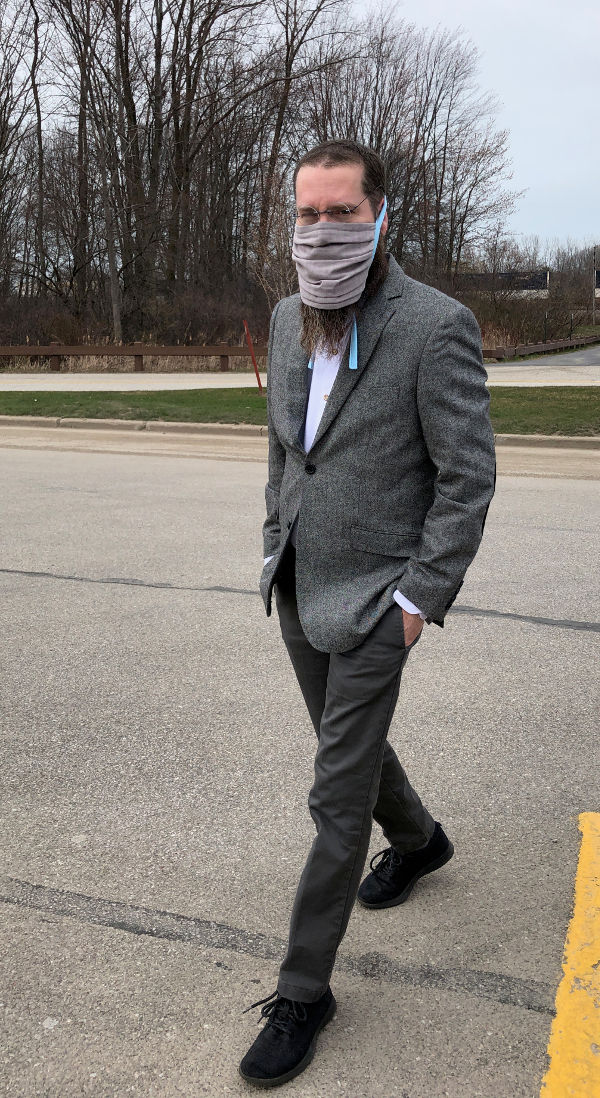
Here is how my child wears it.
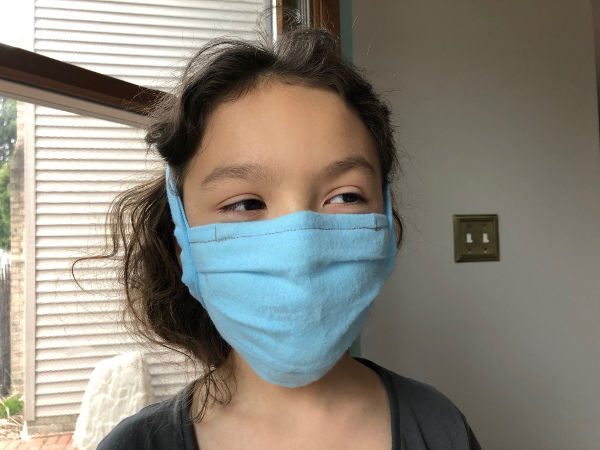
How to apply paper medical tape to prevent fogging up of glasses.
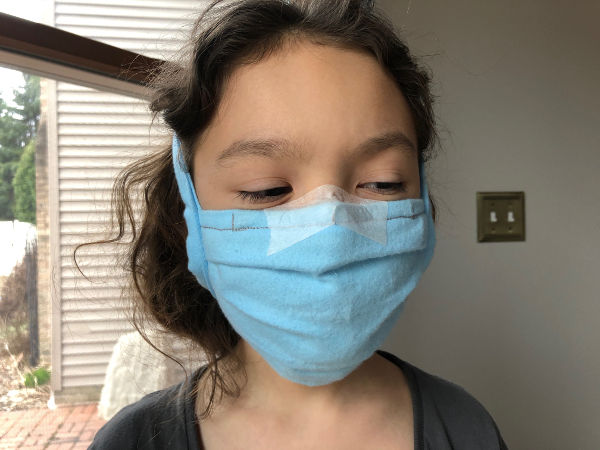
The top ties go towards the top of the head, so it's not pressing on the ears. After hours of surgery, anything pushing on the ears would be very uncomfortable. That's why I made mine with ties, not ear loops.
The bottom ties go under the hair so you can still move your head without moving the mask.
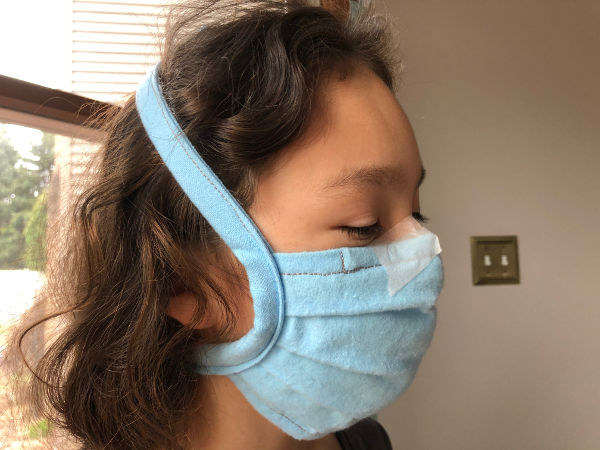
Another view of the top. I tie it so it's easy to untie. You don't want to fiddle too much with it when it's time to take it off, so a shoelace tie that you can just pull out is great.
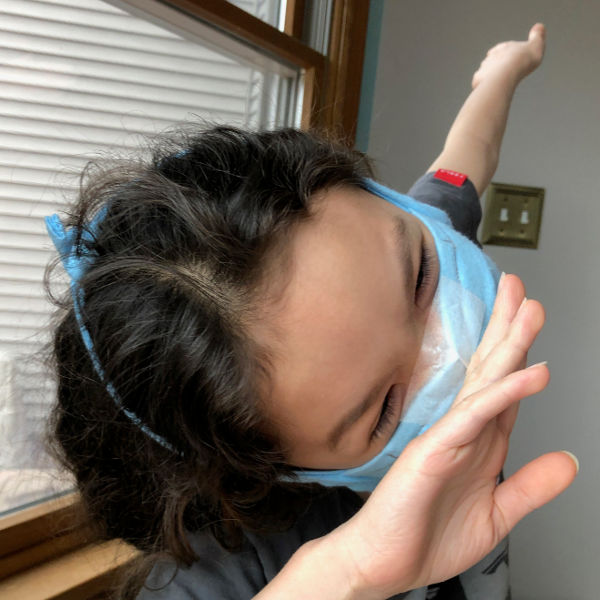
This 3M Micropore Paper Surgical Tape is my favorite tape for the purpose. It's sticky enough but not so much it hurts my skin on removal. Honestly, I was in a rush the other day for the grocery store trip, so I used plain old scotch tape, and that worked fine too.
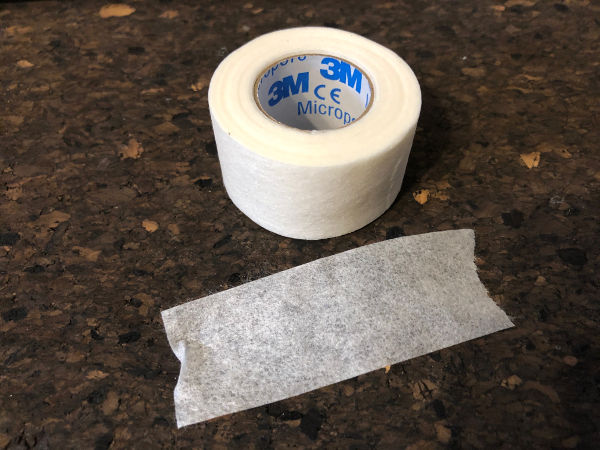
Now you know how to wear a homemade surgical mask, the most comfortable mask style, and all of the special circumstances, including glasses, bearded men, and kids.
June 8, 2020
There are some updated guidelines and research on homemade face masks.
On June 5th, the WHO issued guidance on "non-medical" fabric masks on pages 8-11. Unfortunately, flannel is not specifically mentioned. If you actually read the text, the chart on page 9 is utterly unhelpful. They recommend against knit fabrics (like I did) and yet they list three different knits in there, plus tissue paper and paper towels (which melt with washing). They recommend 3 layers, with the outer layer made from polyester, the inner layer made from cotton, and the middle layer from either. Most polyester fabrics used for clothing are knitted and stretchy. If it's woven, then it's usually super thick (like twill, for tablecloths), which cuts down on breathability. In a quick look around my house, thinner 100% polyester woven fabrics included a gauze curtain and the bag around a sleeping bag. I personally feel that the guidance seems to be a mishmash of different research papers, written by someone who doesn't understand fabrics or sewing. It's confusing and not practical. But since it's from an official organization, I feel that it's important to include it here. One thing I did find interesting is the research on interfacing fabric, which might be an ideal middle layer, if you are planning to sew a 3-layer mask.
The CDC had previously issued guidance on 2-layered masks. They even allowed a 1-layer knit fabric no-sew T-shirt mask. A guy in India suggests using microfiber cloths that are designed to hold on to water, which seems interesting. If you want something super protective like N95 but cannot find any to buy, this is a super cool staple and HVAC filter solution. It would not be washable though. Adding additional layers to the basic mask I described above isn't too hard. I recommend adding pleated layers to the outside of a previously sewn mask.
Even two months after the CDC formally recommended face masks, I still see most people not wearing them correctly. Many people slide it down toward their mouth to breathe easier. People continue to adjust them constantly, touching their face. Many masks are not shaped around the nose with a wire, so air leaks near the top of the nose. Even surgical masks with a wire are not sitting properly on the bridge of the nose, being pulled down for more air. It's obvious that the main problem is comfort. If it's not comfortable, then it won't be worn correctly. If it's not worn correctly, then it doesn't matter how many layers the mask has. It's better to wear just one breathable layer than to have a thick mask down around your mouth.
When you are wearing and talking through a mask all day, the movement of your facial muscles will eventually make it slide down. Therefore, I still strongly recommend using surgical tape to hold the mask to your face. It will direct the airflow through the mask fabric, rather than through gaps. Plus, it will prevent the slow slide down your nose, eventually requiring you to adjust the mask. No matter what type of mask you wear, the tape will help with long-term comfort.
Stay safe, stay healthy, and sleep well!
Click for PDF with step-by-step directions
 This design has been super popular, so we decided to help make it even easier. If you need speaker wire, bias tape (skip steps 15-18, which take a lot of time), and paper surgical tape, we offer them as a small kit now. Click to purchase
This design has been super popular, so we decided to help make it even easier. If you need speaker wire, bias tape (skip steps 15-18, which take a lot of time), and paper surgical tape, we offer them as a small kit now. Click to purchase
 Unable to sew or just want something now? We made a waterproof face mask because we had the fabric. Perfect for outdoor work, rainy areas, or extra protection for your N95 mask. Click to purchase
Unable to sew or just want something now? We made a waterproof face mask because we had the fabric. Perfect for outdoor work, rainy areas, or extra protection for your N95 mask. Click to purchase
Brought to you by AcousticSheep LLC, maker of SleepPhones®, the most comfortable headphones you can wear in bed. SleepPhones® were invented by the author and her husband. Click here for more information. Dr. Lai also blogs about the coronavirus, having almost joined the CDC 15 years ago. 2020 © AcousticSheep LLC
